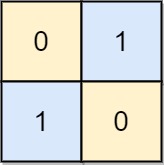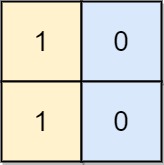- {x}
- Minimize Max Distance to Gas Station
- Global and Local Inversions
- Split BST
- Swap Adjacent in LR String
- Swim in Rising Water
- K-th Symbol in Grammar
- Reaching Points
- Rabbits in Forest
- Transform to Chessboard
- Minimum Distance Between BST Nodes
- Letter Case Permutation
- Is Graph Bipartite?
- K-th Smallest Prime Fraction
- Cheapest Flights Within K Stops
- Rotated Digits
- Escape The Ghosts
- Domino and Tromino Tiling
- Read More...

Transform to Chessboard
You are given an n x n binary grid board. In each move, you can swap any two rows with each other, or any two columns with each other.
Return the minimum number of moves to transform the board into a chessboard board. If the task is impossible, return -1.
A chessboard board is a board where no 0's and no 1's are 4-directionally adjacent.
Example 1:

Input: board = [[0,1,1,0],[0,1,1,0],[1,0,0,1],[1,0,0,1]] Output: 2 Explanation: One potential sequence of moves is shown. The first move swaps the first and second column. The second move swaps the second and third row.
Example 2:

Input: board = [[0,1],[1,0]] Output: 0 Explanation: Also note that the board with 0 in the top left corner, is also a valid chessboard.
Example 3:

Input: board = [[1,0],[1,0]] Output: -1 Explanation: No matter what sequence of moves you make, you cannot end with a valid chessboard.
Constraints:
n == board.lengthn == board[i].length2 <= n <= 30board[i][j]is either0or1.
Solution Explanation for Transform to Chessboard
This problem asks for the minimum number of moves to transform a given binary grid into a chessboard pattern. A chessboard pattern is one where no two adjacent cells have the same value (0 or 1). The moves allowed are swapping rows or columns.
The solution utilizes bit manipulation and pattern observation for efficiency. Let's break it down:
1. Pattern Observation:
-
Row/Column Patterns: In a valid chessboard, rows and columns follow specific patterns. For an
n x nboard:- If
nis even, each row/column hasn/20s andn/21s. - If
nis odd, each row/column has either(n+1)/20s and(n-1)/21s or vice-versa.
- If
-
Limited Valid Patterns: For a given
n, there are only a limited number of valid row/column patterns. This allows us to check for validity efficiently. For example, if the first row is0101..., then all other rows must be0101...or1010....
2. Bit Manipulation for Efficiency:
The solution cleverly uses bit manipulation to represent rows and columns as integers. Each bit in the integer corresponds to a cell in the row/column. This allows for efficient comparison and counting of 0s and 1s.
3. Algorithm Steps:
-
Represent Rows/Columns as Integers: The code first converts the first row and first column of the board into integers using bit manipulation.
rowMaskandcolMaskstore these representations. -
Check for Validity: It iterates through all rows and columns. For each row/column, it checks if its bit representation matches either the initial pattern (
rowMaskorcolMask) or its inverted pattern (revRowMaskorrevColMask). If any row/column doesn't match, the transformation is impossible, and -1 is returned. -
Count Swaps: If all rows/columns are valid, it counts the number of rows/columns that match the initial pattern (
sameRow,sameCol). This information helps determine the minimum number of swaps needed. -
Calculate Minimum Swaps (function
f): The functionfcomputes the minimum swaps for rows/columns based on the bit patterns. It accounts for both even and oddncases. The key is that the minimum swaps are determined by the difference between the actual pattern and the ideal pattern. -
Return Total Swaps: Finally, the code returns the sum of minimum row swaps and minimum column swaps.
4. Time and Space Complexity:
-
Time Complexity: O(n^2) - The algorithm iterates through the
n x nboard once to convert the board to bit representations and to perform the validity check. The rest of the computation is linear with respect ton. -
Space Complexity: O(1) - The algorithm uses a constant amount of extra space to store integer representations of rows and columns and some temporary variables.
Code Explanation (Python):
The Python code directly implements the algorithm described above. The f function efficiently calculates minimum swaps using bitwise operations. The rest of the code focuses on validity checks and counting.
Code Explanation (Java, C++, Go):
The Java, C++, and Go implementations are very similar in structure and logic to the Python solution. They use the equivalent bit manipulation operators and functions available in their respective languages to achieve the same outcome. The __builtin_popcount function in C++ and bits.OnesCount in Go efficiently calculate the number of set bits (1s) in an integer.
The use of bit manipulation significantly improves the efficiency of the solution compared to naive approaches that might involve nested loops and individual cell comparisons. The pattern observation reduces the search space and allows for a direct calculation of the minimum swaps.